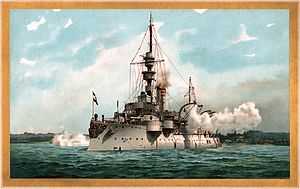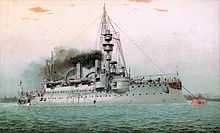Odin-class coastal defense ship
 1902 lithograph of Odin firing a salute | |
| Class overview | |
|---|---|
| Name: | Odin class |
| Operators: |
|
| Preceded by: | Siegfried class |
| Succeeded by: | None |
| Built: | 1893–1896 |
| In commission: | 1896–1919 |
| Planned: | 2 |
| Completed: | 2 |
| Lost: | 1 |
| Retired: | 1 |
| General characteristics | |
| Type: | coastal defense ship |
| Displacement: |
|
| Length: | 79 m (259 ft) |
| Beam: | 15.2 m (50 ft) |
| Draft: | 5.61 m (18.4 ft) |
| Propulsion: |
|
| Speed: | 15 knots (28 km/h) |
| Range: |
|
| Crew: |
|
| Armament: |
|
The Odin class was a pair of coastal defense ships built for the German Kaiserliche Marine in the late 19th century. The class comprised two ships: Odin, named after the Norse god Odin, and Ägir, named after the Norse god of the same name. The ships were very similar to the preceding Siegfried-class coastal defense ships, and are sometimes considered to be one class of ships.
Like the preceding Siegfried-class ships, Odin and Ägir were obsolete by the time World War I had started. Regardless, they were still used in their primary role until 1915, at which point they were withdrawn from active service. The ships performed a variety of secondary duties until the end of the war. On 17 June 1919, both ships were struck from the naval register and sold to the A. Bernstein Company in Hamburg. The shipping company had the ships rebuilt as freighters; Odin served in this capacity until she was scrapped in 1935, however Ägir accidentally grounded near the Karlsö lighthouse on the island of Gotland in 1929 and proved to be a total loss.
Design
General characteristics
The Odin-class ships were 76.4 meters (251 ft) long at the waterline and 79 m (259 ft) long overall. They had a beam of 15.2 m (50 ft) and a draft of 5.61 m (18.4 ft) forward and 5.47 m (17.9 ft) aft. Like the preceding Siegfried class, Odin and Ägir were substantially rebuilt between 1901–03 and 1903–04, respectively. The hulls were lengthened somewhat, to 84.8 m (278 ft) at the waterline and 86.15 m (282.6 ft) overall. The beam was also slightly increased, to 15.4 m (51 ft). Forward draft decreased slightly, to 5.59 m (18.3 ft), while the aft draft increased slightly, to 5.49 m (18.0 ft). The two ships had a designed displacement of 3,550 metric tons (3,490 long tons; 3,910 short tons) and a maximum weight of 2,754 t (2,711 long tons; 3,036 short tons). After the reconstruction, displacement was increased to 4,100 t (4,000 long tons; 4,500 short tons) designed, and a maximum of 4,376 t (4,307 long tons; 4,824 short tons) for Odin and 4,292 t (4,224 long tons; 4,731 short tons) for Ägir.[1]
Odin and Ägir used the same transverse and longitudinal steel frame construction as the Siegfried-class ships. The ships had eight watertight compartments and a double bottom for about 60% of the length of the hull. As in the Siegfrieds, a ninth watertight compartment was added when the ships were lengthened. The ships were described as good sea boats; they had gentle motion and were very responsive to commands from the helm. The ships lost significant speed in heavy seas, however. The ships had a crew of 20 officers and 256 enlisted men, with an additional 6 officers and 22 men when serving as a flagship. The refit increased crew requirements, to an additional 31 sailors normally, and the extra flagship crew increased to 9 officers and 34 men. The ships carried a number of smaller boats, including one picket boat, one pinnace, two cutters, one yawl, and one dinghy.[2]
Propulsion
Odin and Ägir were equipped with the same propulsion system that was in Siegfried: two sets of 3-cylinder triple expansion engines, each in its own engine room. These engines drove a pair of three-bladed screws that were 3.5 m (11 ft) in diameter. Odin had eight marine type boilers, while Ägir 's engines were powered by eight Thornycroft boilers.[2] The ships had similar maximum speeds, with Odin, at 14.4 knots (26.7 km/h; 16.6 mph), somewhat slower than her design speed of 15 kn (28 km/h; 17 mph) and Ägir slightly faster at 15.1 kn (28.0 km/h; 17.4 mph). Their engines were rated at 4,800 indicated horsepower (3,600 kW), though on trials Odin managed only 4,650 ihp (3,470 kW) while Ägir reached 5,129 ihp (3,825 kW).[1]
Odin had three electric generators that provided between 29–26 kilowatts at 67 volts, while Ägir was equipped with six generators that provided between 243–250 kW at 120 V. Because of her increased number of electrical generators, Ägir was nicknamed "Electrische Anna" ("Electric Anna").[2] The ships stored up to 270 t (270 long tons; 300 short tons) of coal which enabled a range of 2,200 nautical miles (4,100 km; 2,500 mi) at a cruising speed of 10 kn (19 km/h; 12 mph). After the refit, fuel bunkerage was increased, to 370 t (360 long tons; 410 short tons) of coal. This increased the sailing range to 3,000 nmi (5,600 km; 3,500 mi) at 10 knots. After 1909, capacity to store 100 t (98 long tons; 110 short tons) of fuel oil was added.[1]
Armament
The ships' primary armament consisted of three 24-centimeter (9.4 in) SK L/35 guns.[2] In an arrangement that was very unusual for such large guns, two of the guns were mounted in a pair of MPL C/88 turrets forward side-by-side, while the third was mounted in a single turret aft. The guns could train 150 degrees to either side of the centerline, and depress to -4 degrees and elevate to 25 degrees. This enabled a maximum range of 13,000 m (43,000 ft).[3] The guns had an ammunition storage of 174 rounds, or 58 shells per gun.[2] The guns had a rate of fire of around 2 shells per minute. The 1895 design for the armor piercing shell weighed 140 kg (310 lb).[3]
The ships also had a secondary battery of ten 8.8 cm (3.5 in) SK L/30 guns with 2,500 rounds of ammunition.[2] The 8.8 cm gun fired a 10 kg (22 lb) projectile at a muzzle velocity of 590 m/s (1,936 ft/s). The guns could sustain a rate of fire of approximately 15 rounds per minute.[4] The ships were also equipped with three 45 cm (18 in) torpedo tubes. Two were placed laterally in above water swivel mounts and the third was submerged in the bow. The torpedo tubes were supplied with a total of 8 torpedoes.[2]
Armor
The ships used a similar Krupp compound steel and teak armor protection scheme as in the preceding Siegfried class. The upper section of the main armored belt was 220 millimeters (8.7 in) thick in the central portion of the ships, where the ships' vitals were located. Behind this was 180 mm (7.1 in) of teak, which gave a total thickness of 400 mm (16 in). The bow and stern were unprotected. The lower section followed a similar pattern of steel armor distribution, although the thickness of the central portion of the belt was decreased to 120 mm (4.7 in). The main armored deck was between 50 mm (2.0 in) and 70 mm (2.8 in) thick; more important areas of the ships were covered by the thicker armor. The conning tower roof was 30 mm (1.2 in) thick and the sides were 120 mm (4.7 in). The barbettes for the main battery and cupolas for the secondary guns ranged in thickness between 30 to 200 mm (1.2 to 7.9 in), backed by 200 mm (7.9 in) of teak.[2]
Service history

Odin and Ägir saw only limited service in their intended roles. The revolutions in capital ship building in the first decade of the 20th century rapidly made these ships obsolete. The Second Naval Law, passed on 27 March 1908, reduced the service life of all capital ships from 25 years to 20 years. This meant that the Odin-class ships, along with a number of other vessels, were to be replaced as soon as possible.[5] Odin and Ägir were replaced by the Kaiser-class battleships König Albert and Prinzregent Luitpold respectively.[6]
As the new battleships were intended for offensive operations, the Odin class was still retained for coast defense duties. The ships served in this capacity through the start of World War I, until they were withdrawn from active service in 1915, along with their half-sisters of the Siegfried class. After she was pulled from combat duties, Odin served as a tender in Wilhelmshaven. She was struck from the naval register on 6 December 1919 and sold to A. Bernstein Co., a shipping company based in Hamburg. By 1922, the ship had been rebuilt as a freighter, and she served in this capacity until she was scrapped in 1935.[1]
Ägir was also stationed in Wilhelmshaven after she was withdrawn from her coast defense duties, though she served as a barracks ship there. She was stricken from the navy list on 17 June 1919, and also sold to A. Bernstein Co. for use as a freighter. On 8 December 1929, the ship grounded off the Karlsö lighthouse on the Swedish island of Gotland. The situation proved to be unsalvageable. Her bow ornament is now on display at the Laboe Naval Memorial.[1]
Footnotes
References
- DiGiulian, Tony (26 November 2007). "Germany 24 cm/35 (9.4") SK L/35". NavWeaps.com. Retrieved 12 June 2009.
- DiGiulian, Tony (22 March 2007). "German 8.8 cm/30 (3.46") SK L/30 8.8 cm/30 (3.46") Ubts L/30". NavWeaps.com. Retrieved 5 June 2009.
- Gardiner, Robert; Gray, Randal, eds. (1985). Conway's All the World's Fighting Ships: 1906–1921. Annapolis: Naval Institute Press. ISBN 978-0-87021-907-8.
- Gröner, Erich (1990). German Warships: 1815–1945. Annapolis: Naval Institute Press. ISBN 978-0-87021-790-6. OCLC 22101769.
| ||||||||||||||